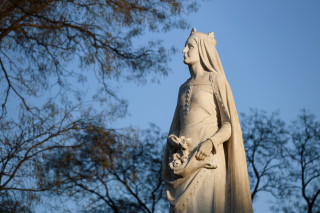
Elizabeth was the daughter of King Andrew II of Hungary and Gertrude of Merania. Her uncle was King Béla IV. She was born in 1207, probably in Sárospatak, as the third of five children. In the manner of the times, Elizabeth’s hand was promised to Hermann, son of the Landgrave of Thuringia when she was four years old. Elizabeth moved first to Eisenach and then to Wartburg, where the benevolent nature and kindness of the young girl soon won over the court. When Hermann died in 1216 at the age of 19, she was his betrothed to his younger brother Ludwig, who was also Elizabeth’s best friend. The wedding was held in Eisenach in 1221, after which Elizabeth enjoyed a joyous marriage to Ludwig, 7 years her senior. They had three children, Hermann (1222), Sophie (1224), and Gertrude (1227). After the death of his father, Ludwig acceded to the throne of Thuringia at the age of 18. Elizabeth had a big house built at the foot of the castle, where she took in pilgrims and beggars and cared for the sick. In 1225, as a vassal to Frederick II, Holy Roman Emperor, Ludwig was sent off to war and Elizabeth took over the task of governing the province, working hard to mend the hurts caused by famines and epidemics, opening Wartburg’s storerooms to feed the need. She herself lived a life of temperance. After becoming infected with the plague, Ludwig passed away in camp on September 11, 1227. In his letter to Elizabeth, Pope Gregory IX comforted her with fatherly words and appointed the strict Conrad as her confessor and official protector. Ludwig’s younger brothers stripped his 20-year-old widow of the right to handle his estate as well as the income she would have received from his assets. The situation forced her to leave Wartburg unnoticed on a day in October. Bishop Eckbert in the city of Bamberg took her in at the Pottenstein Castle, and later Elizabeth moved to Marburg. On Good Friday, 1228, Elizabeth joined the Third Order of Saint Francis, renouncing worldly goods in the presence of a congregation of Franciscan monks. She proceeded to start building a hospital where she welcomed the sick and the homeless, and she cared for them herself. She dressed in a simple grey smock. She died on the night of November 16, 1231 in Marburg. In 1236, construction of St. Elizabeth’s Church was started over the burial site. It was completed in 1283 and houses both her grave and a reliquary. Elizabeth was canonized by Pope Gregory IX in 1235. In Hungary, King Béla IV built the first church in her honor, in the town of Kápolna.
Elizabeth is perhaps best known for her miracle of the roses. While taking bread to the poor in secret, hidden in her cloak, she encountered her husband, who asked what she had with her. Elizabeth told Ludwig she was carrying roses, and when she revealed what was hidden in her cloak, there was nothing to be seen but roses. This legend has caused St. Elizabeth to be often portrayed with roses in her iconography. According to another legend, Elizabeth once laid a leprous beggar in her husband’s bed so she could care for him. Upon his return, his husband stormed into the room and found the crucified Christ in his bed, helping him comprehend his wife’s boundless love.
Franz Liszt wrote an oratorio entitled The Legend of St. Elizabeth in her honor.